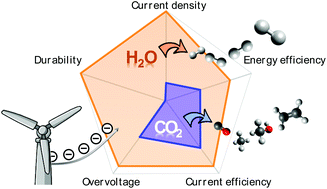Towards sustainable fuels and chemicals through the electrochemical reduction of CO2: lessons from water electrolysis
Abstract
The storage of renewable energy through the electrochemical reduction of CO2 (eCO2RR) is an attractive strategy to transform the current linear utilisation of carbon fuels (extraction–combustion–CO2 release) into an increasingly cyclic one. An electrochemical alternative for energy storage is the production of H2 from water splitting, studied for decades and commercially available up to the megawatt range. By comparing the technological similarities between these two processes, it is possible to extract both a global perspective and research directions for the eCO2RR. Herein, the main limiting phenomena affecting CO2 electrolysers and their causes are outlined first. This is followed by the derivation, for several eCO2RR products, of targets in terms of durability, current efficiency, energy efficiency, faradaic efficiency, and overvoltage, which must be achieved for the eCO2RR to reach a similar energy storage capability as the electrochemical production of H2. By comparing these figures of merit with the eCO2RR literature, we conclude that the conversion of carbon dioxide to carbon monoxide and formic acid lead the race towards practical use, although both still exhibit major performance gaps. The present energy efficiencies are low, mainly due to high overvoltages, and durability is not yet a developed research area. Besides the development of more efficient electrocatalysts, research advances on the fronts of electrode and electrolyser design, coupled with the optimisation of methods for the preparation of electrodes, are expected to push forward the electrochemical reduction of CO2 on its way to viability.

- This article is part of the themed collections: Celebrating the 2017 RSC Prize and Award Winners and 3rd International Symposium on Green Chemistry

 Please wait while we load your content...
Please wait while we load your content...